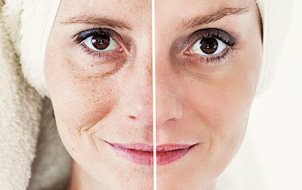Pictures of Age Spots To Help You Diagnose Your Blemishes
When you think of laser treatments, you might immediately picture hair removal. But did you know that modern advancements in technology now allow professional skincare clinics like CoLaz Affordable Laser Hair Removal to offer an array of incredible skin treatments? These treatments can help address a variety of skin concerns beyond just removing unwanted hair. The laser treatment process involves directing intense beams of light at areas of dark pigment. This is why laser hair removal tends to work best on individuals with darker hair and lighter skin tones. Blemishes, moles, age spots, skin tags, freckles, and other forms of discoloration absorb the laser light, which heats them up until they break down and fade away. At CoLaz, we provide a range of services designed to enhance your skin health and appearance. Our offerings include: If you've noticed blotchy patches appearing on your hands, face, chest, or other areas, those could very well be age spots—visible signs of sun damage. While wrinkles are a common concern related to prolonged sun exposure, age spots often emerge during middle age as a result of too much time under the sun without proper protection. Age spots can initially be unsettling since no one wants to look their age prematurely. However, the solution doesn't have to be complicated. Some products claim to lighten these spots using harsh chemicals and bleaches, but the scientifically-backed, most effective method for completely eradicating sun damage is through laser therapy. The images displayed here showcase common types of blemishes that can be effectively treated with laser procedures. If you suspect that one of your age spots may have the potential to be cancerous, however, it's always wise to consult with a dermatologist first to rule out any serious conditions. I hope these photos have given you clarity about whether your blemishes are suitable candidates for laser removal at CoLaz. We're passionate about helping people feel and look better—and younger! Feel free to reach out with any questions regarding this treatment or anything else we offer. You can also click here to contact us online. Taking the first step toward a more confident you has never been easier. Contact us now to schedule your consultation and discover how we can help transform your skin! Hematology analyzer is also called clinical blood cell analyzer, blood cell analyzer, blood cell analyzer, blood cell counter. The blood analyzer not only improves the accuracy of the experimental results, but also provides many experimental indicators, which play an important role in the diagnosis and differential diagnosis of diseases. Hematology analyzer is one of the most widely used instruments in hospital clinical testing. Automation in Hematology,Automated Hematology Analyzer,Hematology Analyzer Instrument,Hematology Analyzer Product Jilin Sinoscience Technology Co. LTD , https://www.jlgkscience.comLaser Treatments for Age Spots
Photos of Age Spots



Book Your Consultation with CoLaz Today
Test items
Blood cell test refers to routine blood test, which is manual operation and counting under the microscope at first. It includes red blood cell, hemoglobin, white blood cell count and its classification, platelet count, etc. There are more than 20 items.
clinical significance
1. The blood analyzer is mainly used to detect various blood cell counts, white blood cell classification and hemoglobin content.
2. Hematocrit: obtained by multiplying the average volume of red blood cells by the red blood cell count.
3. Red blood cell distribution width: represents the degree of consistency of red blood cell size. When the red blood cell size is uneven, the red blood cell distribution width value increases, such as various types of nutritional deficiency anemia.
4. The three average indices of red blood cells are used to identify the type of anemia.
(1) The average hemoglobin content of red blood cells: increased in megaloblastic anemia, decreased in iron deficiency anemia, chronic blood loss anemia, uremia, chronic inflammation.
(2) Mean volume of red blood cells: increase in hemolytic anemia and megaloblastic anemia; decrease in severe iron deficiency anemia and hereditary spherocytosis.
(3) The average red blood cell hemoglobin concentration: decrease in chronic blood loss anemia, iron deficiency anemia; various diseases can be in the normal range. In megaloblastic anemia, the mean red blood cell volume increases, the mean red blood cell hemoglobin amount increases, the mean red blood cell hemoglobin concentration is normal, and the red blood cell distribution width increases.
5. Average platelet volume: the average volume of each platelet, the size of platelets is related to its function.
(1) Increased: seen in patients with idiopathic thrombocytopenic purpura, edema and proteinuria in late pregnancy.
(2) Decreased: seen in non-immune platelet destruction, aplastic anemia, thrombocytopenia repeated infection syndrome, chronic myeloid leukemia, etc.